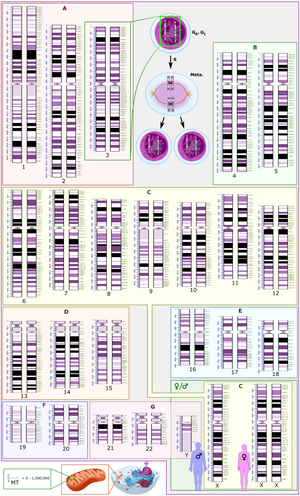The International System for Human Cytogenomic Nomenclature (ISCN; previously the International System for Human Cytogenetic Nomenclature) is an international standard for human chromosome nomenclature, which includes band names, symbols, and abbreviated terms used in the description of human chromosome and chromosome abnormalities.
The ISCN has been used as the central reference among cytogeneticists since 1960.[1][2]


Abbreviations of this system include a minus sign (-) for chromosome deletions, and del for deletions of parts of a chromosome.[4]
- ^ Slovak M.L., Theisen A., Shaffer L.G. (2013) "Human Chromosome Nomenclature: An Overview and Definition of Terms." In: Gersen S., Keagle M. (eds) The Principles of Clinical Cytogenetics. Springer, New York, NY doi:10.1007/978-1-4419-1688-4_3
- ^ Brothman AR, Persons DL, Shaffer LG (2009). "Nomenclature evolution: Changes in the ISCN from the 2005 to the 2009 edition". Cytogenet Genome Res. 127 (1): 1–4. doi:10.1159/000279442. PMID 20110655.
- ^ Warrender JD, Moorman AV, Lord P (2019). "A fully computational and reasonable representation for karyotypes". Bioinformatics. 35 (24): 5264–5270. doi:10.1093/bioinformatics/btz440. PMC 6954653. PMID 31228194.
{{cite journal}}: CS1 maint: multiple names: authors list (link)
- "This is an Open Access article distributed under the terms of the Creative Commons Attribution License (http://creativecommons.org/licenses/by/4.0/)" - ^ "ISCN Symbols and Abbreviated Terms". Coriell Institute for Medical Research. Retrieved 2022-10-27.